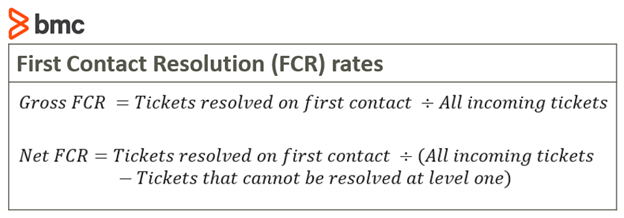Whether you’re running a Help Desk or a Service Desk, one of the more important IT support metrics to track is first contact resolution (FCR). Let’s look at the FCR metric, including calculating and defining it, best practices, and strategies for improvement.
What is first contact resolution?
First contact resolution is the percentage of incoming service calls or requests that are resolved during the first interaction with the customer, eliminating the need for the customer or IT Support to follow up with a second contact.
FCR is one of many IT support metrics organizations can track.
What makes FCR critical?
Tracking your IT Support first contact resolution rate is important for two main reasons. First, FCR is a key driver of customer satisfaction, which should and must be measured. High FCR rates are usually associated with high levels of customer satisfaction.
FCRs can be measured in tandem with other metrics. For example, look at FCR alongside Average Talk Time (aka Average Handle Time) for service calls—that is, the amount of time an agent spends with a customer during a call—as a combined metric for measuring customer satisfaction. An industry maxim states that fast Average Talk Time rates combined with low FCR rates may be a signal of low customer satisfaction.
Second, FCR rates also affect IT Support staffing. Low FCR rates usually indicate more follow-up calls for customer issues, which require more service desk agents to service the available calls. A high FCR rate may indicate that IT Support is properly addressing customer needs the first time, reducing or eliminating the need for the customer or IT Support to follow up with a second contact.
Depending how you set up your IT service desk metrics, the FCR can also indicate how well you’ve trained your service desk agents, the tools you make available to your agents (such as diagnostics, remote access, etc.), and even your efficiency and ability to service more people with fewer resources.
How do you measure FCR?
Given that you can’t improve what you don’t measure, and you can’t measure what you can’t define, how do you define FCR? FCR is usually measured either as gross FCR or net FCR, using these equations:
Net FCR is a more valuable and commonly used metric because many tickets simply can’t be resolved on first contact. Hardware requisitions, software rollouts, and local or regional issues, such as an email or Internet outage, will require many touches and support levels to resolve. When calculating your net FCR rate, you’ll need to first define which tickets are FCR-eligible and only count those tickets.
Best practices for measuring FCR
Besides using Net FCR over Gross FCR, FCR measurement can get complicated in the following areas. As with any metrics, you’ll need to adjust your measurements accordingly to look at realistic IT and business outcomes Here are some tips for more accurately measuring FCR:
Adjust first contact resolution for direct and indirect tickets
With so many different channels for entering service tickets, organizations need to adjust their definition of what constitutes first contact resolution, based on whether each service ticket was entered directly or indirectly and through which channel.
Service desk contacts resolved immediately through directly answered phone calls or chat sessions should automatically count as first contact resolution tickets.
Conversely, you may have to adjust your definition for when service ticket resolution occurred, for tickets that are initiated indirectly through voicemail, email, company Web site, or social media channels (Twitter, LinkedIn, Facebook, etc.).
Indirect tickets may be considered first contact resolved if the resolution and notification occur within the organization’s Service Level Agreement (SLA). For example, consider an organization providing a three-hour response time for service tickets. If the service ticket isn’t resolved and the customer isn’t informed until the next business day, the ticket should not be considered as first contact resolved. Other organizations may not make indirect service tickets eligible for first contact resolution. Consider if and how you want to count indirect tickets in your FCR strategy. Also, consult your SLAs for your specific requirements and whether that affects your first contact resolution definition.
Decide whether a ticket was resolved on first contact
It’s not a trivial question to ask whether individual tickets were resolved on first contact. Some of the more common ways of scoring first contact resolution status for directly and indirectly answered tickets are:
- Automated counting. The ticketing software determines if the ticket was resolved on the first call and automatically marks the ticket as an FCR resolution.
- Agent reporting. For directly initiated tickets, the IT Support agent decides whether the ticket was resolved on the first contact and marks the ticket as such. If using agent reporting, you should perform monthly ticket auditing to make sure your agents are accurately reporting their FRC tickets.
- Customer/self-reporting. The customer is issued a post-call survey asking whether the ticket was resolved on the first contact, and the ticket is marked yes or no on first contact resolution based on their response.
Define first contact resolution when live transfer occurs
Many people assume FCR means that if the customer contacts IT Support and IT Support solves the issue in a single unbroken contact, the ticket was resolved on first contact. But what if the customer contacts IT Support, the agent performs level 1 diagnostics, and then hands the ticket off to a level 2 agent as a live transfer? If the level 2 agent was able to solve the issue on the handoff from the level 1 service agent, was the ticket resolved on the first contact? Some organizations would say yes, while others might say no.
It’s important to determine boundaries for whether to include live transfer tickets in your Net FCR rate.
Consider FCR and reopened tickets
If a ticket that’s marked as FCR resolved is reopened because the issue recurred, is its FCR rating revoked? It’s common practice for organizations to keep a ticket open for 24 hours after resolution and reopen the ticket if the customer reports back that the fix didn’t work. It’s important to take reopened tickets into account when determining your FCR rates.
These issues are critical to performing honest FCR tracking. Make sure you have your FCR eligibility and tracking criteria defined, that all involved parties know your FCR criteria, and that your system is set up to count FCR tickets based on that criteria. Being consistent in marking and counting FCR tickets is critical to getting an honest count—without honest, accurate numbers, that metric would be useless to your organization.
Improve FCR with these four tips
So, you’ve measured your FCR and you’re not happy with it—perhaps your customers aren’t satisfied either. The Service Desk needs to improve their FCR rates. How do you do it? Give your service desk agents a head start with these four ways to improve FCR rankings:
-
Empower Tier 1 support to perform Tier 2 tasks
Eliminate the need for tier 1 support agents to escalate certain calls to tier 2 support by giving them the knowledge and authority to solve common issues.
If it’s common for example, for a tier 1 agent to escalate email address changes to tier 2 support, consider whether you want to train and authorize tier 1 agents to perform this task. Look at the items that tier 1 typically escalates and ask whether any of them can be accomplished by tier 1 agents with the right authorities and a script for making the change or fix. The more tasks or tickets that tier 1 agents can solve, the more often the task will be completed on first contact. -
Create knowledge base items for common, easily fixable items
One of the reasons that tickets get escalated is that the customer or tier 1 support doesn’t have the knowledge to fix the ticket on their own. Analyze incoming tickets and determine which items can be easily fixed by the customer or lower level IT support through a knowledge document. Make those knowledge documents accessible and your first contact resolution rates will increase, as specific incidents, events, and requests won’t need escalation.
-
Automate common problems
Implement self-service automation for common ticket items. One of the most common IT support items is password resets—the customer has an expired or forgotten password. Implementing and training your customers in using an automated self-service password reset system would provide immediate help in resetting expired or forgotten passwords, particularly on weekends when fewer IT support personnel are available. Automation can increase customer satisfaction if it can easily fix a problem without having to contact the support desk.
-
Improve the process
Perform ticket analysis to determine the customer’s common pain points, where things frequently go wrong, and what technical support must step in to fix. Then, fix those problems. Issue elimination improves FCR rates. It also reduces the number of IT support calls—something both staff and customers will cheer.
Additional resources on IT service metrics
Correctly implemented, first contact resolution is an important IT support metric for improving customer service satisfaction. Using this simple metric on a regular basis can help you determine whether you’re implementing the proper steps to increase customer satisfaction.
BMC Blogs has many resources on IT service desk metrics and best practices. Browse our Enterprise IT Glossary or see these articles:
- Cost Per Ticket: The Ultimate Service Desk Metric
- Tickets Per User as a Service Desk Metric
- Agent Utilization as a Service Desk Metric
- Mean Time to Resolve (MTTR) as a Service Desk Metric
- Introduction to Critical Incident Response Time (CIRT): A Better Way to Measure Performance
- Creating a Service Desk Code of Conduct







